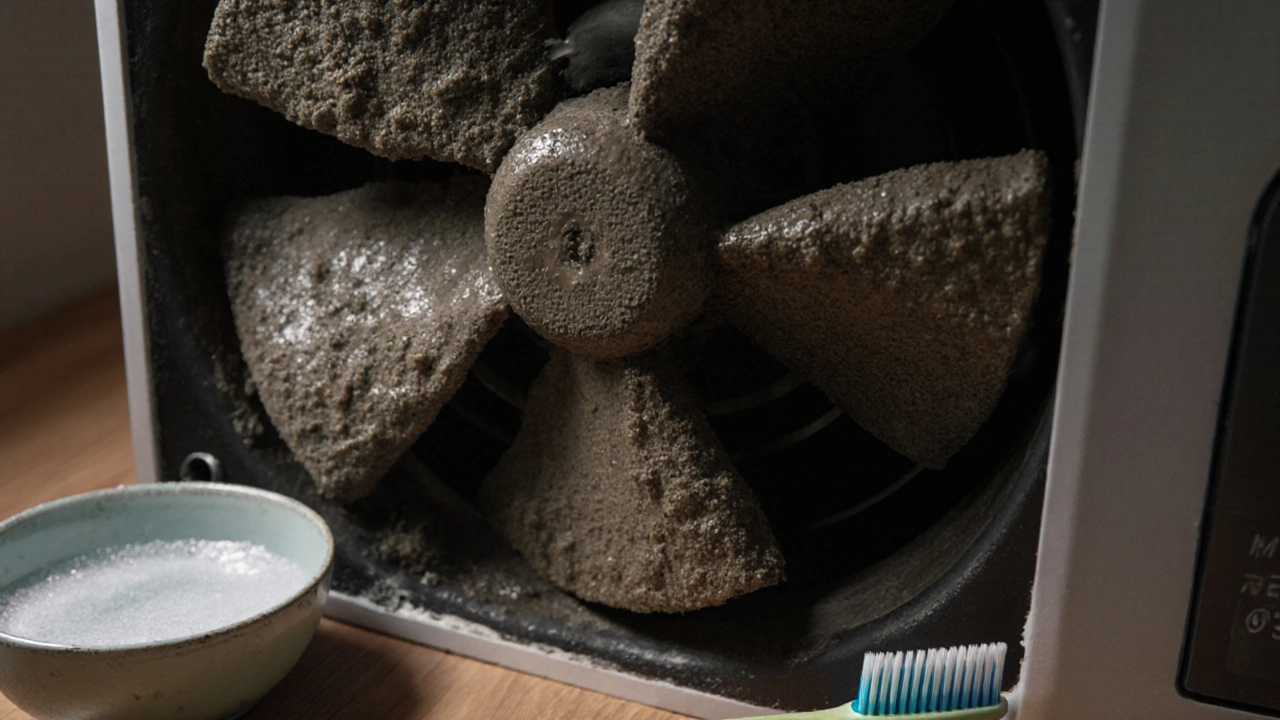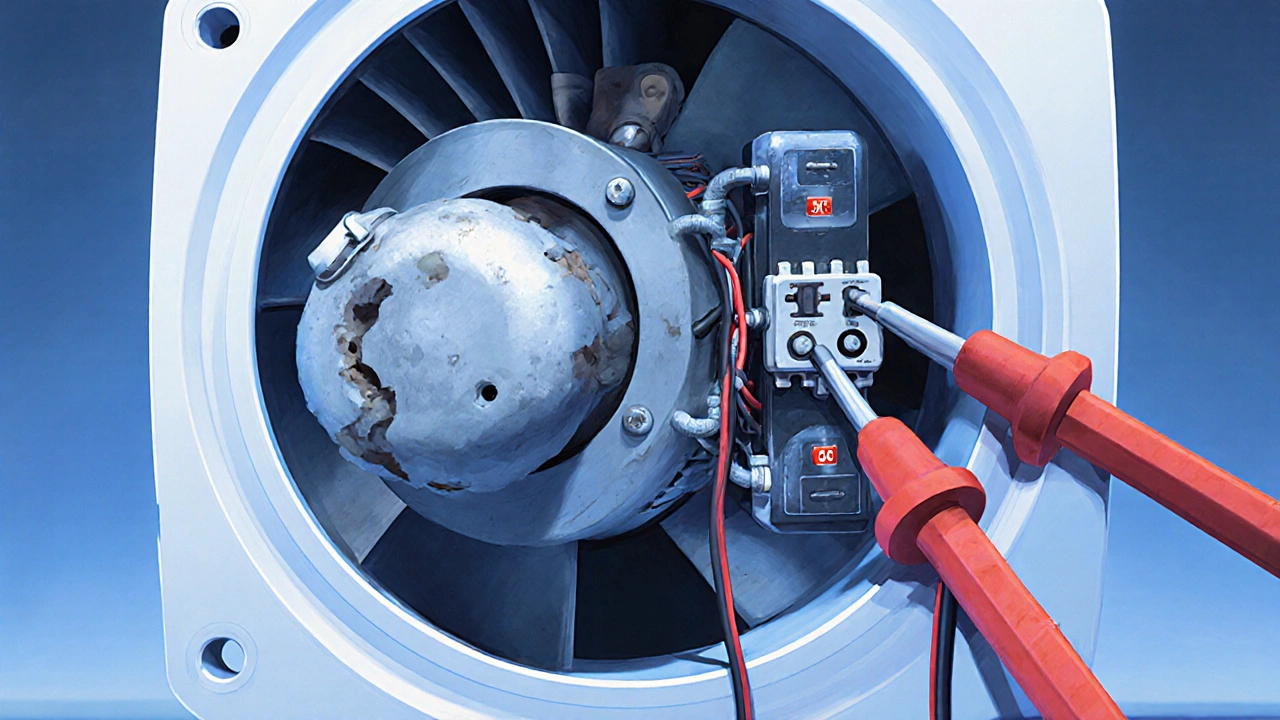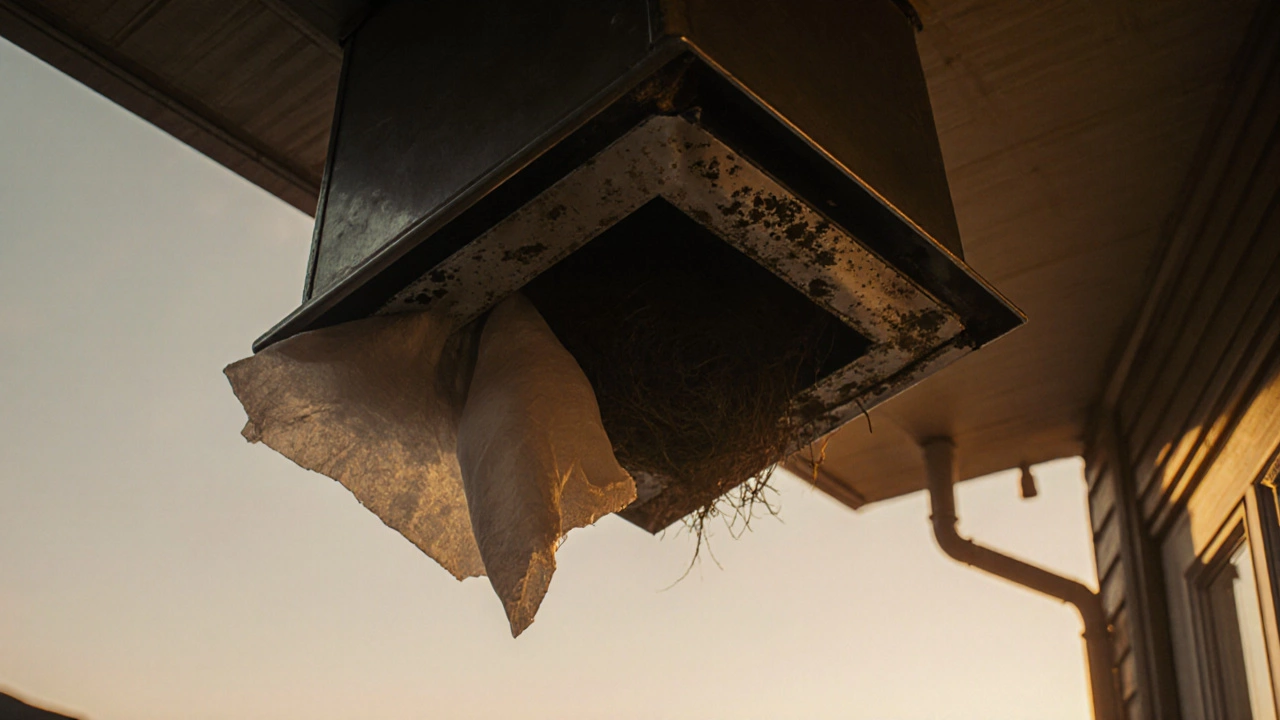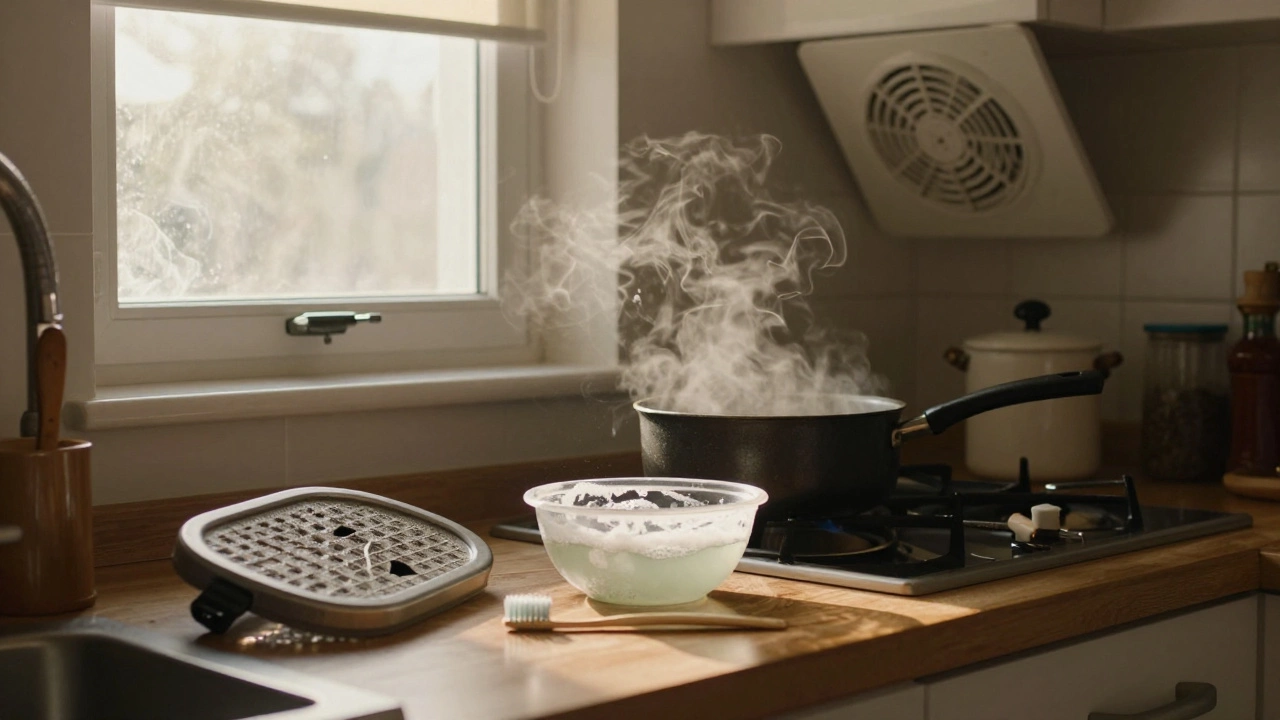
- 18 Nov 2025
- Gideon Thornton
- 0
Ever turned on your kitchen extractor fan and heard nothing but silence? It’s not just annoying-it’s a safety issue. Without proper ventilation, smoke, grease, and moisture build up, leaving your kitchen sticky, smelly, and ripe for mold. The good news? Most extractor fan failures aren’t mysterious. They’re predictable. And almost always fixable without calling a pro.
Grease buildup is the #1 killer
Every time you fry eggs, sear steak, or boil pasta, tiny grease particles float into the air. Your extractor fan catches them. But over time, that grease doesn’t just disappear. It sticks to the blades, the motor housing, and the ductwork. After 2-3 years without cleaning, that layer becomes thick enough to jam the fan.
When grease builds up, the motor has to work harder. It drags. It strains. It overheats. Eventually, the thermal cut-out kicks in and shuts the fan down to prevent fire. You’ll hear a faint hum but no spin. Or worse-the fan starts, sputters, then stops after five seconds.
Check this first: Turn off the power. Remove the grease filter. Hold it up to the light. If you can’t see through it, it’s clogged. Now look at the fan blades. If they’re coated in dark, sticky sludge, that’s your culprit. A simple soak in hot soapy water, followed by a scrub with a toothbrush, fixes 60% of no-spin cases. Clean the housing too. Don’t skip this step. Grease doesn’t just sit on the blades-it creeps into the motor bearings.
Motor failure isn’t always the end
Extractors run nonstop during cooking. That’s 10-20 minutes a day, 7 days a week. Over 8-12 years, the motor windings wear out. Bearings dry up. Capacitors fail. The motor might still click when you flip the switch, but it won’t turn.
Before replacing the whole unit, test the motor. Unplug the fan. Disconnect the wires from the motor. Use a multimeter to check for continuity. Set it to ohms (Ω). Touch the probes to the motor terminals. If the reading is infinite (OL), the motor is dead. If it reads between 5 and 50 ohms, the motor is still good.
Here’s what most people miss: The capacitor. It’s a small silver or black cylinder wired to the motor. If it’s bulging, leaking, or smells burnt, swap it. A new capacitor costs $5. It’s the most common fix for fans that hum but don’t spin. You can buy one at any hardware store. Match the microfarad (µF) rating and voltage. Most kitchen extractors use 2.5µF or 3µF at 400V.
Wiring and switches wear out faster than you think
Every time you flip the switch, tiny sparks jump across the contacts. Over time, those sparks burn away the metal. The switch gets loose. It doesn’t make full contact. The fan works sometimes. Or only on high speed. Or only after you jiggle the switch.
Check the wall switch first. Turn off the circuit breaker. Remove the faceplate. Look for blackened or melted plastic around the terminals. Wiggle the switch. If it feels loose or clicks oddly, it’s done. Replace it with a standard single-pole switch. Same price as a coffee. Same effort.
Now check the wiring inside the fan housing. Look for frayed wires, loose connectors, or insulation that’s cracked. Rodents love to chew on wires tucked behind cabinets. If you see bite marks or exposed copper, turn off the power and replace the damaged section. Use wire nuts rated for 600V. Don’t just tape it.

Duct blockages are silent killers
Even if the fan spins perfectly, it won’t pull air if the duct is blocked. That’s why you still smell fried fish after cooking. The fan’s running-but the air can’t escape.
Most kitchen extractors vent through a 150mm (6-inch) duct. That duct runs up through the ceiling, into the attic, and out the roof. Over time, it collects grease, dust, bird nests, or even collapsed sections. If the duct runs long, bends sharply, or has no slope, condensation builds up. That turns into mold. Or ice in winter.
Test your duct: Tape a lightweight tissue to the outside vent. Turn the fan on. If the tissue doesn’t flap, the duct is blocked. Remove the vent cap outside. Shine a flashlight in. Look for debris. Use a vacuum with a long nozzle to suck out the gunk. If the duct is flexible aluminum, straighten any kinks. If it’s rigid PVC or metal, clean it with a duct brush. You can buy one online for $20.
Never vent into the attic. That’s a code violation and a mold factory. Always vent to the outside. If your duct ends in the attic, fix it now. It’s not just about smell-it’s about structural damage.
Power issues are often overlooked
Is the fan dead on all settings? Check the circuit breaker. A tripped breaker is the easiest fix. But sometimes, it’s not the breaker-it’s the outlet. Plug a lamp into the same outlet. If it doesn’t turn on, the circuit is dead. Try another outlet on the same circuit. If none work, your kitchen circuit is overloaded or faulty.
Older homes often have 10-amp circuits for kitchens. Modern extractors draw 5-8 amps. Add a microwave or toaster, and you’re over the limit. That causes the breaker to trip intermittently. If this happens often, you need an electrician to install a dedicated 15-amp circuit.
Also check the plug. If the fan is plugged in (not hardwired), the plug prongs might be loose or corroded. Wiggle the plug. If the fan turns on and off while you move it, the plug is bad. Replace it. It takes five minutes.

When to replace instead of repair
Not every fan is worth saving. If your extractor is over 15 years old, it’s likely using outdated parts. Replacement motors are hard to find. Energy efficiency is poor. Noise levels are loud. Modern extractors use brushless motors, run quieter, and pull 30% more air with half the power.
Here’s your decision tree: If you’ve cleaned the grease, replaced the capacitor, fixed the switch, cleared the duct, and checked the power-and it still doesn’t work-it’s time to replace. If the housing is cracked, rusted, or warped, don’t bother repairing. New units start at $80. Install one yourself in under an hour.
Look for models with: removable grease filters, reversible airflow (for island hoods), and low noise ratings (under 50 dB). Brands like Bora, Zephyr, and Falmec offer reliable options. Avoid no-name brands sold on marketplaces. Their motors fail in under two years.
Prevent future failures
Fixing a broken fan is one thing. Keeping it running for another decade is another. Here’s how:
- Wash the grease filter every 2 weeks. Soak it in hot water with baking soda.
- Deep clean the fan blades and housing every 6 months.
- Check the duct for blockages once a year.
- Replace the capacitor every 5-7 years, even if it’s still working.
- Never run the fan on high for more than 30 minutes at a time.
Simple habits save you hundreds in repairs. And they keep your kitchen safe.



